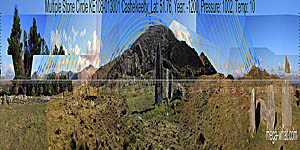 On excavation in 1977 (Lynch 1981:65-69), two Standing Stones and a third, prostrate stone turned out to be the remains of a Multiple Stone Circle.
It was originally of 11 or 13 stones, diameter c.17m, but was destroyed before peat formation and considerable later disturbance.
The only find, apart from stone sockets, was a flint scraper. No plan or section diagrams were published.
This site is about about 75m to the north-west of a Stone Row and Five-Stone Circle.
On excavation in 1977 (Lynch 1981:65-69), two Standing Stones and a third, prostrate stone turned out to be the remains of a Multiple Stone Circle.
It was originally of 11 or 13 stones, diameter c.17m, but was destroyed before peat formation and considerable later disturbance.
The only find, apart from stone sockets, was a flint scraper. No plan or section diagrams were published.
This site is about about 75m to the north-west of a Stone Row and Five-Stone Circle.
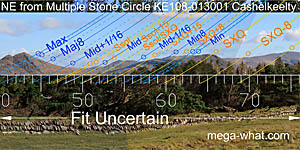 This view to the north-east was taken from higher ground, so as to see over the forestry. The fit is thus conjectural rather than accurate but the fit has been informed by
computer calculated data.
This view to the north-east was taken from higher ground, so as to see over the forestry. The fit is thus conjectural rather than accurate but the fit has been informed by
computer calculated data.
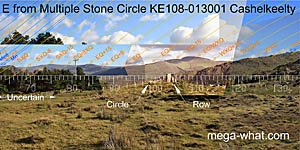 Use of the eastern horizon is essentially the same as from the row and five stone circle though more of it is obscured by nearby trees.
The difference in position of the two sites does not make much of a difference to a horizon at that distance and the exact locations have been chosen to ensure it.
Notice that the equinox is at the lowest point on this horizon segment.
Use of the eastern horizon is essentially the same as from the row and five stone circle though more of it is obscured by nearby trees.
The difference in position of the two sites does not make much of a difference to a horizon at that distance and the exact locations have been chosen to ensure it.
Notice that the equinox is at the lowest point on this horizon segment.
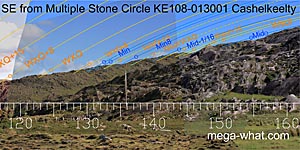 There is an obvious shift in positions with nearer skylines.
The rocky south-east ridge has a sufficiently rugged profile to make a good measuring tool but solar and lunar positions on it are not particularly significant apart from the solstice.
There is an obvious shift in positions with nearer skylines.
The rocky south-east ridge has a sufficiently rugged profile to make a good measuring tool but solar and lunar positions on it are not particularly significant apart from the solstice.
Winter solstice sun rose in the dip at the top of the ridge, before passing behind the pointed rock, which was thus a very sensitive pointer to both upper and lower limbs. Having barely cleared the horizon, the sun would then set into the hillslope before mid-day, still rising.
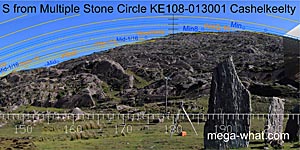 This location was chosen to utilise the the slopes of Knocknaveacal as very sensitive indicators.
The solstice has been mentioned. At lunar mid-cycle, the moon would rise at the foot of the hill and set again almost immediately, having briefly cleared the slope's lowest point by a semi-diameter.
During the major half of the lunisticeLunistices are the most northerly and southerly moons of the month. The lunar equivalent of solstices - more.
cycle, the most southerly moons of the month would never rise at all.
This location was chosen to utilise the the slopes of Knocknaveacal as very sensitive indicators.
The solstice has been mentioned. At lunar mid-cycle, the moon would rise at the foot of the hill and set again almost immediately, having briefly cleared the slope's lowest point by a semi-diameter.
During the major half of the lunisticeLunistices are the most northerly and southerly moons of the month. The lunar equivalent of solstices - more.
cycle, the most southerly moons of the month would never rise at all.
The tallest remaining stone is likely to be the western portal, thus the orientation of the circle would have been due south towards the eastern end of the hilltop which marked the halfway point between the cross-quarter and the winter solstice.
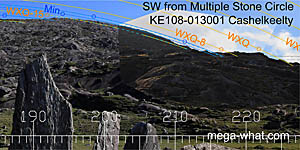 The hilltop itself is a half-month south of the cross-quarters and the lunar minor eighth also occurs there whilst the moon's lower limb grazes the western slope as it approaches minor
standstillLunistice positions vary cyclically over an 18.6 year period but are fairly static for more than a year at either end of the range.
The hilltop itself is a half-month south of the cross-quarters and the lunar minor eighth also occurs there whilst the moon's lower limb grazes the western slope as it approaches minor
standstillLunistice positions vary cyclically over an 18.6 year period but are fairly static for more than a year at either end of the range.
The minor end of the lunisticeLunistices are the most northerly and southerly moons of the month. The lunar equivalent of solstices - more. cycle could be measured very accurately as it occurs on a north facing slope and a natural rock pointer at the bottom [Photo] indicated centre disc at minor standstillLunistice positions vary cyclically over an 18.6 year period but are fairly static for more than a year at either end of the range.
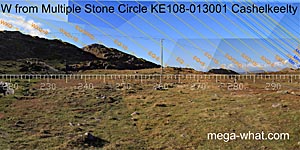 The cross-quarter has an obvious marker on the hillside and the equinox has one at the end of a flat section of local ground.
The halfway point between them is indicated by the intersect of nearby hill and further mountain top.
The cross-quarter has an obvious marker on the hillside and the equinox has one at the end of a flat section of local ground.
The halfway point between them is indicated by the intersect of nearby hill and further mountain top.
North of the equinox a useful stretch of distant horizon ends a quarter-month from the summer cross-quarter.
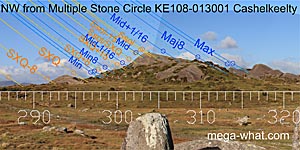 The north-western horizon is mostly very close. Local rock outcrops mark out the lunisticeLunistices are the most northerly and southerly moons of the month. The lunar equivalent of solstices - more.
range and the summer part of the solar cycle.
The solstice sun sets into the tallest rock which nicely complements the curious winter solstice arrangement.
The north-western horizon is mostly very close. Local rock outcrops mark out the lunisticeLunistices are the most northerly and southerly moons of the month. The lunar equivalent of solstices - more.
range and the summer part of the solar cycle.
The solstice sun sets into the tallest rock which nicely complements the curious winter solstice arrangement.
A cairn has appeared on top of this rock outcrop in the years since first publication of this page explained its ancient significance!
- Utilisation of this skyline by the Stone Row and Five-Stone Circle about 75m to the east is less satisfactory, which indicates that they are the later monuments.
- Similar use of a high southern horizon may also be seen at Barrees Stone Pair, about 8km to the west.
- The better preserved Shronebirrane Stone Circle, 2.25km to the SSE as the crow flies, has even more spectacular use of high horizons.
- Ardgroom Multiple Stone Circle, c.3km south-south-west is another good one.
References
- Archaeological Survey of Ireland, record details. www.archaeology.ie/archaeological-survey-ireland
- BYRNE, ELIZABETH, et.al. 2009 Archaeological Inventory of County Kerry, Volume 1: South West Kerry. Dublin: Stationary Office. p13, no.50.
- LYNCH, ANN 1981 Man and the Environment in South-West Ireland, 4000 BC-AD 800. BAR British Series 85. Oxford: British Archaeological Reports.
- Ó'NUALLÁIN, SEÁN 1984 A Survey of Stone Circles in Cork and Kerry. Proceedings of the Royal Irish Academy 84c:1-77, p29, no.47.
- RUGGLES, C.L.N. 1999 Astronomy in Prehistoric Britain and Ireland. Newhaven & London: Yale University Press. No. ASC30.
